| The Personal Appearance of Christopher Columbus | ||
Munsey's Magazine Volume LIX
October, 1916 Number 1 pp. 48-55.
The Personal Appearance of Christopher Columbus.
by
Frank Owen Payne
Of all the great men who have played a momentous part in the history of the modern world, there is probably none of whom so much has been written and said, but of whom so little is positively known, as the discoverer of America.
We have a considerable collection of the letters and the writings of Christopher Columbus. He was known to many of the statesmen and historians of his day, who put on record some interesting incidents of his life. A whole library of books has been produced by later investigators. And yet we do not know where or when he was born; there is uncertainty as to the resting-place of his remains; there is controversy as to his real name and the race to which he belonged.
His character is variously portrayed in the darkest and in the brightest colors; and as for his personal appearance, there is much doubt whether any of the hundreds of existing portraits of Columbus have any authority as likenesses.
Seven cities claimed Homer as a native, but there have been no less than twenty-three conflicting statements or theories as to the scene of the birth of Columbus. True, the navigator himself declared that he was born in Genoa, but the truth of his assertion has been questioned. A building in the suburbs of the old Italian seaport has been shown as the house in which he first saw the light, but apparently without any evidence to support the claim.
In a recent number of Munsey's Magazine there was a picture of the monument in the stately cathedral of Seville, under which the bones of Columbus are said
To touch very briefly upon the controversy as to the character of Columbus, Washington Irving and Prescott praise him to the skies, while Justin Winsor declares these historians to have been guilty of most extravagant hero-worship. De Lorgues pronounces Columbus to have been a saint, but Aaron Goodrich accuses him of cupidity, ingratitude, arrogance, perfidy, and treachery, and asserts that his prevailing traits were hypocrisy and deceit combined with cowardice and cruelty.
In the face of such contradictory pronouncements, one is
forced to use one's own judgment in forming an opinion of this
remarkable man, whose genius and perseverance opened up a new
world to civilization. It is an unquestioned fact that for four
centuries he has stood as the embodiment of patient, persistent
effort, of untiring enthusiasm and zeal. Until more convincing
evidence to the contrary can be found, he will continue to be
what he has been—a shining example to the youth of all lands,
inspiring each new generation with hope and confidence and
ambition to strive nobly for great ideals.
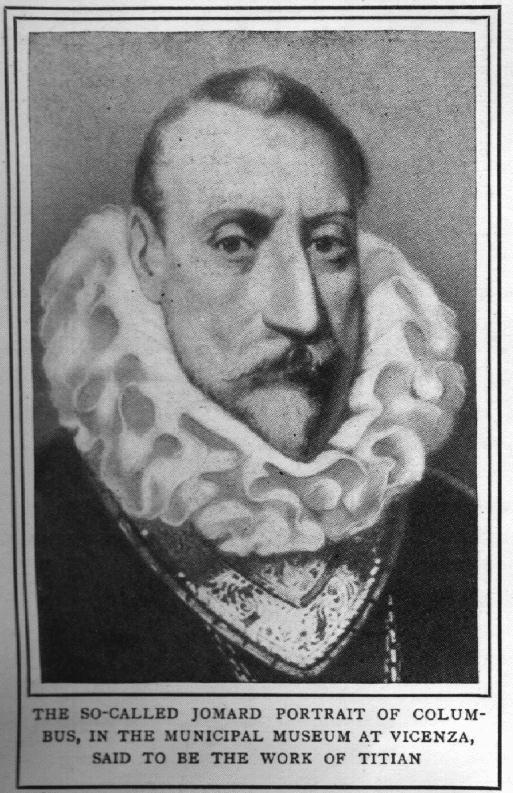
THE SO-CALLED JOMARD PORTRAIT OF COLUMBUS, IN THE MUNICIPAL
MUSEUM AT VICENZA, SAID TO BE THE WORK OF TITIAN
[Description: grayscale; head and shoulders portrait with large ruff]
THE PORTRAITS OF COLUMBUS
It is a universal desire among men to know how the great characters of the past appeared as they walked among their fellows. About five hundred different portraits of Columbus are known to collectors, but there is no proof that any one of them was painted or drawn from life. There is no record that he ever sat to an artist, and one of his most careful biographers declares that all the existing portraits are based on nothing more than "pure fancy." They certainly differ in the most extraordinary way, as will be seen from the specimens reproduced on these pages. Whether there is or is not a truthful presentment among them, most of them must be utterly inaccurate.
There is a verbal description of Columbus by his son Fernando, which ought to be trustworthy. Moreover, in many respects, though not in all respects, it tallies with what we learn from four other authorities. It tells us that the navigator was of more than medium stature, well formed, neither lean nor corpulent, of long visage, with high cheekbones. His nose was aquiline, his eyes light, his complexion fair and of a "lively color." His son says that his hair became white at the age of thirty, but the Spanish historian Oviedo, who saw him in Barcelona
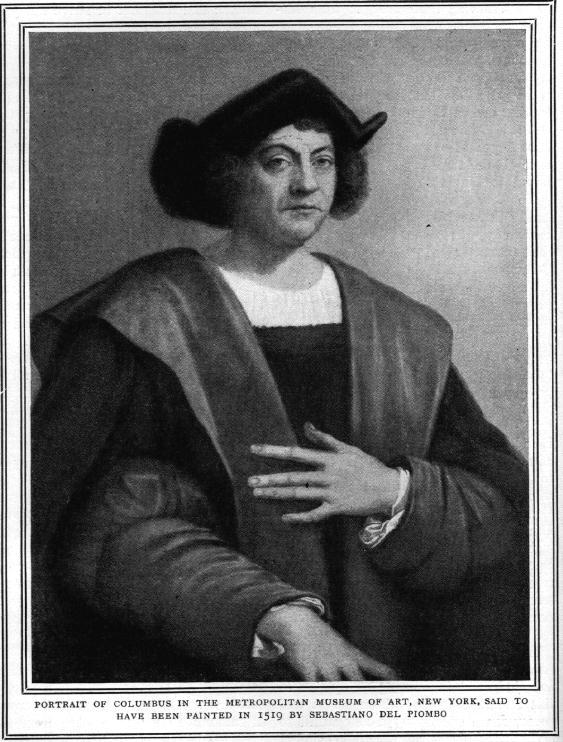
PORTRAIT OF COLUMBUS IN THE METROPOLITAN MUSEUM OF ART, NEW YORK, SAID TO HAVE BEEN PAINTED IN 1519 BY SEBASTIANO DEL PIOMBO
[Description: grayscale; head and torso portrait, with hat]THE JOMARD PORTRAIT
Any representation of Columbus which shows characteristics radically different from these cannot be accepted as a faithful portrait of the man.
Nine of the most interesting portraits are reproduced here. The first, on page 49, was found at Vicenza, in northern Italy, by M. Jomard, librarian of the National Library in Paris. It is attributed—just upon what evidence does not appear—to the brush of the great Venetian painter Titian. It is not at all
Whatever may be its claim to authenticity, this portrait is markedly unlike other representations of Columbus. It shows the "long visage" of the verbal description already quoted, but in other respects it suggests an Elizabethan courtier rather than any accepted impression of the great sailor's personality.
On page 50 is an engraving of a fine portrait now in the
Metropolitan Museum of Art, New York. If the recorded pedigree
of this picture is correct, it was painted in 1519 by Sebastiano
del Piombo, one of the great Venetian artists of the Renaissance.
It was presented to the museum by the late J. Pierpont Morgan,
who purchased it from the collection
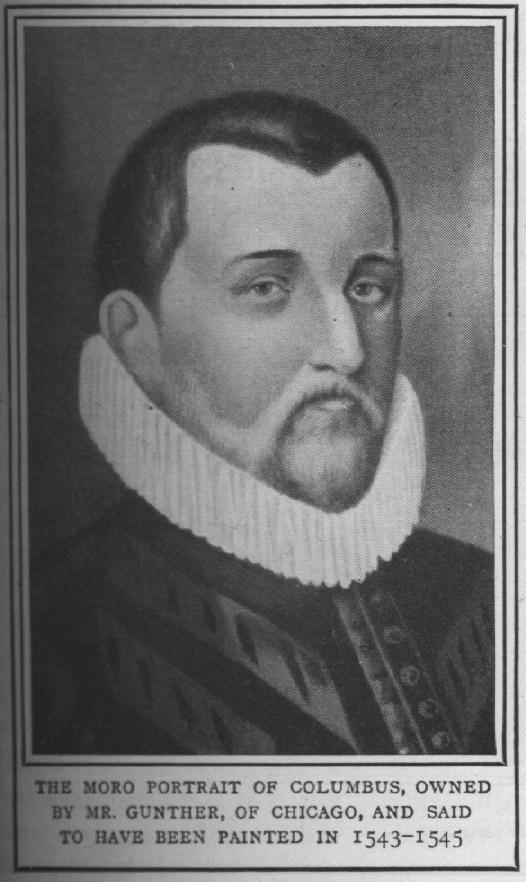
THE MORO PORTRAIT OF COLUMBUS, OWNED BY MR. GUNTHER, OF
CHICAGO, AND SAID TO HAVE BEEN PAINTED IN 1543-1545
[Description: grayscale; head and shoulders portrait, with beard and ruff]
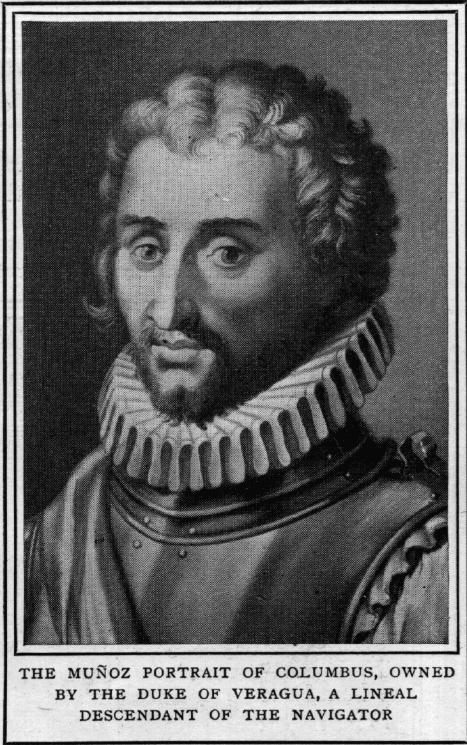
THE MUNOZ PORTRAIT OF COLUMBUS, OWNED BY THE DUKE OF VERAGUA, A
LINEAL DESCENDANT OF THE NAVIGATOR
[Description:
grayscale; head and shoulders portrait, with beard and ruff]
The next engraving, on this page, shows a portrait which belongs to the Duke of Veragua, a lineal descendant of Columbus. It was executed by a Spanish painter, Sebastiano Munoz, who flourished in the latter part of the seventeenth century. As the navigator had then been dead for nearly two hundred years, it cannot claim historical authority, and it is quite unlike the more generally accepted representations.
THE ANTONIO MORO PORTRAIT
It must be admitted, however, that there is some similarity between the
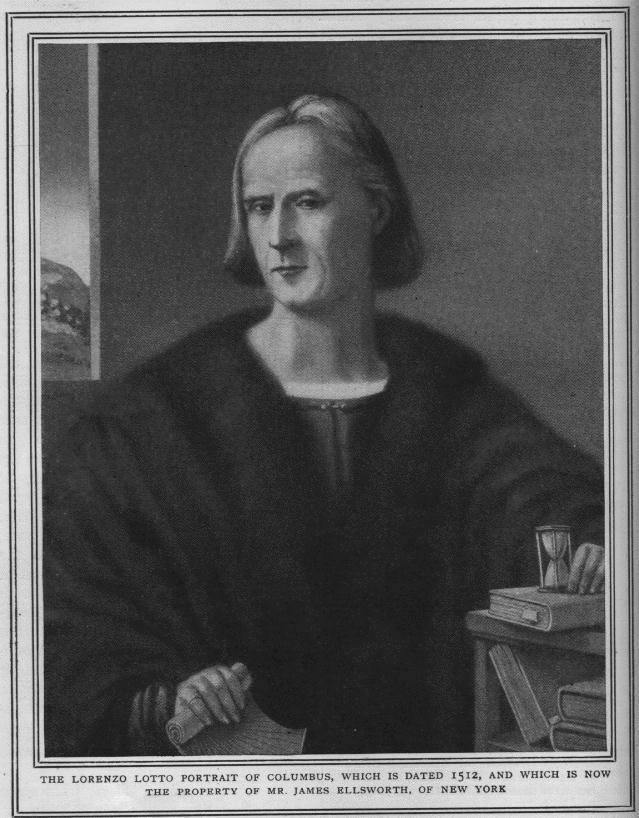
THE LORENZO LOTTO PORTRAIT OF COLUMBUS, WHICH IS DATED 1512, AND WHICH IS NOW THE PROPERTY OF MR. JAMES ELLSWORTH, OF NEW YORK THE PERSONAL APPEARANCE OF CHRISTOPHER COLUMBUS
[Description: grayscale; head and torso portrait, with hourglass, books and parchment ]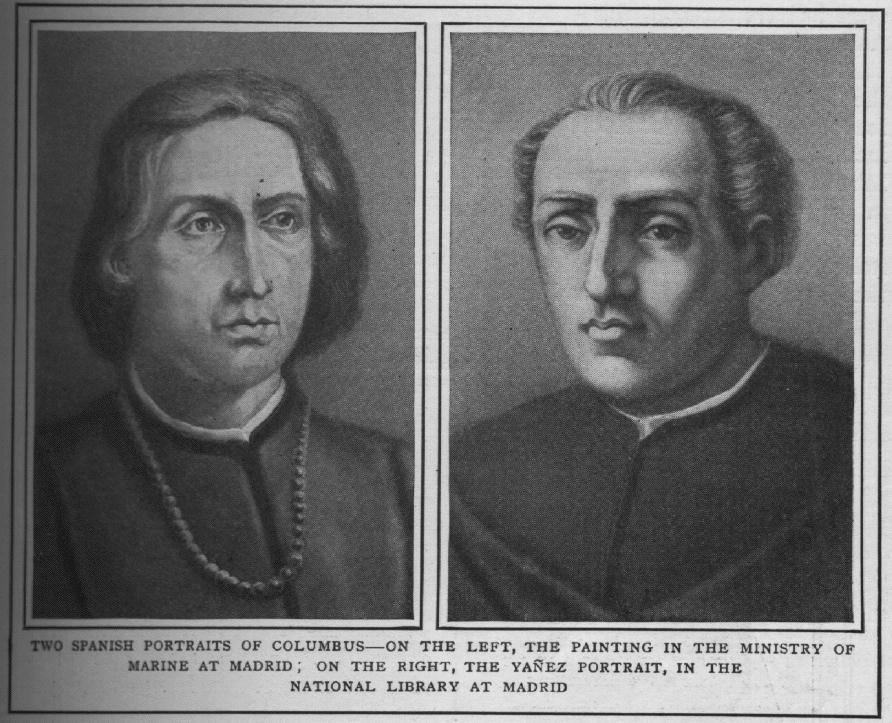
TWO SPANISH PORTRAITS OF COLUMBUS: ON THE LEFT, THE PAINTING, IN THE MINISTRY OF MARINE AT MADRID; ON THE RIGHT, THE YANEZ PORTRAIT, IN THE NATIONAL LIBRARY AT MADRID
[Description: grayscale; two head and shoulder portraits, one with beads]The portrait of Columbus prefaced to the present volume is from a beautiful picture painted by Sir Anthony Moro for Margaret governess of the Netherlands. It was brought, to this country [England] about the year 1590, and has been in possession of one family until very recently, when it was purchased by Mr. Cribb, of King Street, Covent Garden, London.
The characteristics of the mind and features of Columbus are so forcibly depicted in this picture that no doubt can remain but that it is a true and perfect resemblance of the great navigator.
The exclusion of all possible doubt in regard to a matter so difficult of actual proof would appear to be somewhat arbitrary, but Mr. Gunther's picture is a valuable and interesting one.
THE LORENZO LOTTO PORTRAIT
Another fine painting of Columbus is owned by an American collector—the Lorenzo Lotto portrait, which was exhibited at the Columbian Exposition in 1893, and which is now the property of Mr. James Ellsworth, of New York. An engraving of it appears on page 52.
It is noteworthy, not to say curious, that so many of the older portraits of Columbus should be identified as the work of Venetian painters whose early life was contemporary with the navigator's last years. Lotto was born in or about 1480, and this work is dated 1512—six years after the death of Columbus.
It has a record of ownership by the steward of Margaret of Parma—illegitimate daughter of Charles V, and already mentioned in the quotation from Washington Irving—and subsequently by several titled European families. As a likeness, in spite of a certain touch of weakness in the pictured face, it may be classed with the Sebastiano del Piombo portrait, and with that in the Ministry of Marine at Madrid, to be noticed shortly. It tallies fairly well with the descriptions of Columbus, and with the most generally approved idea of his appearance.
Most modern historical painters who have had occasion to depict Columbus
TWO SPANISH PORTRAITS OF COLUMBUS
Both of the portraits reproduced on page 53 are in Madrid, and both are among the most familiar pictures of Columbus. Again, however, there is no proof of their authenticity.
The first of the two was painted for the Spanish Ministry of
Marine as one of
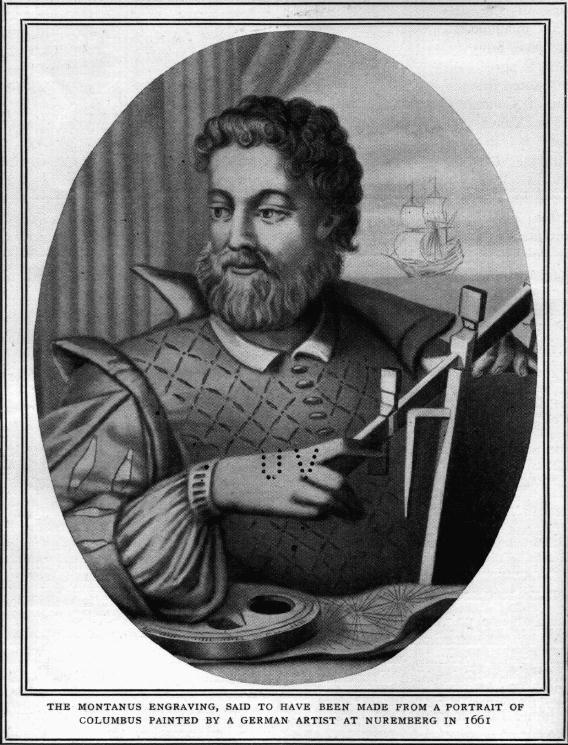
THE MONTANUS ENGRAVING, SAID TO HAVE BEEN MADE FROM A PORTRAIT
OF
COLUMBUS PAINTED BY A GERMAN ARTIST AT NUREMBERG IN 1661
[Description: grayscale; seated head and torso portrait with beard and instruments;
sailing vessel in background]
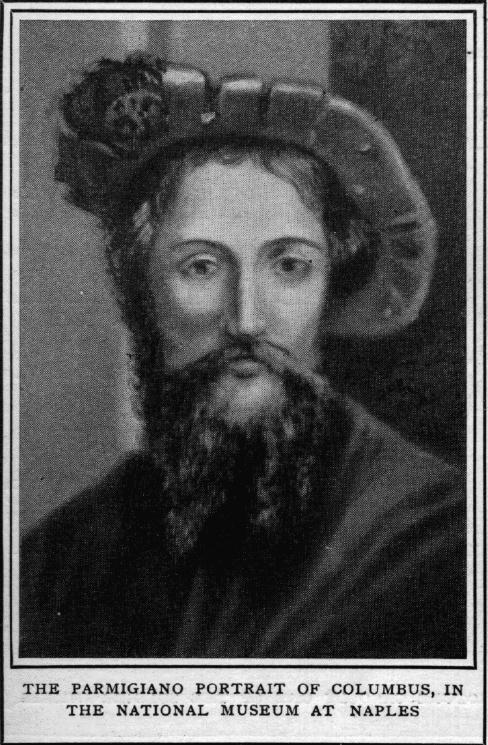
THE PARMIGIANO PORTRAIT OF COLUMBUS, IN THE NATIONAL MUSEUM AT NAPLES
[Description: grayscale; head and shoulders portrait, with beard and hat]The Yanez portrait is in the National Library, Madrid. When acquired for that collection it showed Columbus with a fur collar; but as there was evidence that this detail had been added by the brush of a later and inferior painter, it was decided to remove it. The result, as will be seen, corresponds closely with the same part of the portrait in the Ministry of Marine.
THE MONTANUS ENGRAVING
The Montanus engraving, printed on page 54, is said to have been taken from painting executed by a German artist at Nuremberg, in 1661. Its chief interest lies in its almost complete dissimilarity to all the rest of the series, and it is presented here chiefly as an illustration of the extraordinary diversity of the portraits of Columbus. One can scarcely believe that the strenuous and daring explorer who discovered America could possibly have had the heavy, expressionless features given him by this Teutonic painter.
Equally unsatisfactory is the weak and almost effeminate Columbus that looks cut at us from the portrait shown on this page. This is a reproduction of a canvas that hangs in the large but not very interesting collection of paintings in the National Museum of Naples. It is a work of Francesco Maria Mazzola, better known as Parmigiano, who was only three years old when the navigator died, and it seems safe to set it down as being purely a work of fancy.
Parmigiano is known to have been none too conscientious an artist. For instance, he was imprisoned at Bologna in 1537 for accepting payment for a series of frescoes and then failing to execute them.
Whatever may have been the actual physical semblance of the discoverer of America, we have a right to expect to see in all portraits of him something of that strength of character which made him travel so insistently from country to country seeking assistance in his great undertaking, and something of that dignified and noble bearing which enabled him to withstand the derision of the wise men of his time, the wrath of the elements, and the mutiny of his companions.
Columbus has been too often considered as one who went out to find the Indies and stumbled accidentally upon an unknown world. This is not a fair statement of his achievement. He went out to seek "the islands of Antipodia," and he "sailed on" until he found the thing he sought. Only in those portraits which give him a strong and noble cast of countenance can we find a satisfying likeness of this remarkable man.
| The Personal Appearance of Christopher Columbus | ||